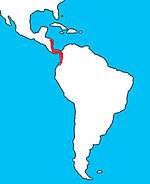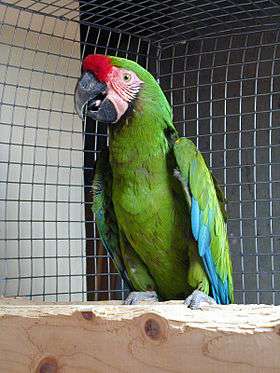Great green macaw
| Great green macaw | |
|---|---|
| | |
| Scientific classification | |
| Kingdom: | Animalia |
| Phylum: | Chordata |
| Class: | Aves |
| Order: | Psittaciformes |
| Family: | Psittacidae |
| Subfamily: | Psittacinae |
| Tribe: | Arini |
| Genus: | Ara |
| Species: | A. ambiguus |
| Binomial name | |
| Ara ambiguus (Bechstein, 1811) | |
| subspecies | |
|
Ara ambiguus ambiguus | |
 | |
| A. ambigua distribution range | |
The great green macaw (Ara ambiguus), also known as Buffon's macaw or the great military macaw, is a Central and South American parrot found in Nicaragua, Honduras, Costa Rica, Panama, Colombia and Ecuador. This species live in the canopy of wet tropical forests and is highly dependent on the almendro tree (Dipteryx panamensis). Two allopatric subspecies are recognized; the nominate subspecies (Ara ambiguus ambiguus) occurs from Honduras to West Colombia, while Ara ambiguus guayaquilensis is isolated on the Pacific side of the continent in Ecuador, and possibly South-Western Colombia.[2]
Taxonomy
The Great green macaw belong to the genus "Ara", which includes other large parrots, such as the scarlet macaw, the military macaw, and the blue-and-yellow macaw.[3] The binomial name has recently been changed from Ara ambigua to Ara ambiguus.
There are two geographically isolated subspecies; Ara ambiguus ambiguus,which has the largest distribution range (Central and the North of South America) and Ara ambiguus guayaquilensis, which occurs mostly in Ecuador.[3][4]

Description
Great green macaws are the largest parrots in their natural range, the second heaviest macaw species (although are relatively shorter tailed than other large macaws such as the red-and-green macaw and are thus somewhat shorter), and the third heaviest parrot species in the world. This species averages 85–90 cm (33.5–35.5 in) in length and 1.3 kg (2.9 lb) in weight.[5] They are mainly green and have a reddish forehead and pale blue lower back, rump and upper tail feathers. Tail is brownish red tipped with very pale blue. The bare facial skin is patterned with lines of small dark feathers, which are reddish in older and female parrots.[6]
The great green macaw appears superficially similar to, and may easily be confused with the military macaw where their ranges overlap.
Distribution and habitat
The great green macaw lives in tropical forests in the Atlantic wet lowlands of Central and South America from Honduras to Western Ecuador.[7] It is usually observed below 600 m, but can be seen as high as 1500 m above sea level at some times of the year. In Costa Rica, the range of the great green macaw is restricted to 1120 km2 of very wet forests along the border with Nicaragua where there are populations in the Bosawas and San Juan reserves, which represents only 10% of its historical range.[4][8][9] Even though it is now rare near the rìo platano in Honduras, it still occurs there.[4] In Panama, it can be observed on the Caribbean slope, near Cana and Alturas de Nique, and the adjacent Colombia.[4]
Before 1994 very few things were known about the natural history of the great green macaws and their abundance was in a sharp decline. In order to improve our knowledge on the ecology and natural history of this bird, a large radio telemetry was conducted by a team of researchers between 1994 and 2006. The main objectives of this study were to determine the home range of A. ambiguus, characterize the habitats that it frequents and learn more about its natural history in general (feeding habits, ecological associations, abundance, and reproduction and nesting habits).[8] The results of this study were published in 2007. It was found that, in Costa Rica and adjacent Panama, the habitats where great green macaws occur were dominated by the mountain almendro (Dipteryx panamensis (or D. oleifera)), oilbean trees (Pentaclethra macroloba) and raffia palms (Raphia spp.).[9] This is not surprising considering that great green macaws depend on D. panamensis for both feeding and nesting.[7]
Another study published in 2007 revealed that the abundance of food within a habitat is not related to the abundance of macaw; however the researchers found that there was a link between the abundance of food and the amount of time great green macaws spend at one place.[10]
Behaviour
Diet
The Buffon's macaw is known to feed 37 species of trees, including the mountain almendro (Dypterix panamensis), Sacoglottis trichogyna, Vochysia ferruginea and coco (Lecythis ampla), which compose most of its diet.[9] Even though great green macaw consume the fruits of a great variety of trees, D. panamensis is its major source of food. In facts, they rely so much on this tree that the seasonal movements of A. ambiguus follow the asynchronous ripening of D. panamensis fruits.[11] In Ecuador, two Buffon's macaw were observed eating orchids, which composed 71% of their diet.[4]
Reproduction
The great green macaw's breeding season starts in December and ends in April, but the time and duration vary depending on the location.[12] Before building a nest, a pair establishes a large territory that does not overlap with that of other couples, and then, they find a tree cavity in which they can build a nest.[13] Dipteryx panamensis is the nesting substrate 90% of the time.[9] The female lays 2-3 eggs and incubates them for about a month period.[12] This species has high reproductive success (60% of young survive), which is not surprising given its relatively small clutch size.
Vocalisation
A loud "aak, raak" that can be heard at great distances.[11]
See external links for an example
Conservation
Status
This species of parrot is still endangered all over its range even though the numbers seems encouraging. In 1994, the population of Costa Rica was estimated at 210 individuals with only 35 to 40 breeding pairs.[4][7] Following conservation efforts, the population of macaws in Costa Rica was estimated at 1530 individuals.[4][7] In Colombia, they seemed to do relatively well in 2005 as the population was estimated at a total of less than 2500 individuals (or 1700 adults).[4] The total population of Ecuador was estimated between 60 and 90 individuals in 2002, and reports from 2012 indicates that there are probably only 30 to 40 individuals left.[4] The global population is now estimated at 7000 individuals, including adults and juveniles.[7]
Threats
The main threat for the survival of the great green macaw is habitat loss, which is mainly due to the unsustainable harvest of Dipteryx panamensis and other trees that produce high quality wood.[7][8] The forests are also converted into agricultural field destined to the production of monocultures like that of African palm, pineapples and bananas.[7][8] As a results, 90% of suitable habitats have been lost in Costa Rica.[8]
Other threats include hunting pressure for the feathers and illegal pet sale.[8]
Conservation plan
In 1998 a research team started to work with local and national stakeholders on a conservation plan, known as the San Juan-La Selva Biological Corridor, that would protect the habitat of the great green macaw.[7] This plan includes the creation of the Maquenque National Wildlife Refuge, which covers 54 000 hectares of breeding ground for the macaw.[7] The conservation plan efficiently reduced the rate of deforestation and was rated as a success in 2012.[7]
The San Juan-La Selva Biological Corridor is extremely important to the great green macaw and hundreds of other species because it restores the connectivity between different regions of Costa Rica and Nicaragua.[7] Essentially, the park connects the Central Volcanic Mountain range and the La Selva Biological Station (125,691 hectares), the Barra del Colorado National Wildlife Refuge (102,165 hectares), Tortuguero National Park (29,068 hectares), the Indio-Maíz Biological Reserve (306,980 hectares), Punta Gorda (54,900 hectares) and Cerro Silva (339,400 hectares), thereby unifying these six protected areas and allowing the animals to move between the regions.[7]
In the culture
A festival building local pride for the great green macaw and promoting its conservation is held simultaneously in both Costa Rica and Nicaragua during May. During the festival local farmers and nest caretakers receive prizes for helping the conservation of the.[8] See external link.
See also
References
- ↑ BirdLife International (2013). "Ara ambiguus". IUCN Red List of Threatened Species. Version 2013.2. International Union for Conservation of Nature. Retrieved 26 November 2013.
- ↑ Forshaw, Joseph M.; Cooper, William T. (1981) [1973, 1978]. Parrots of the World (corrected second ed.). David & Charles, Newton Abbot, London. ISBN 0-7153-7698-5.
- 1 2 "Ara ambiguus". ITIS. 2006.
- 1 2 3 4 5 6 7 8 9 "Great Green Macaw (Ara ambiguus) - BirdLife species factsheet". BirdLife International. 2015. Retrieved 13 October 2015.
- ↑ CRC Handbook of Avian Body Masses, 2nd Edition by John B. Dunning Jr. (Editor). CRC Press (2008), ISBN 978-1-4200-6444-5.
- ↑ "Species factsheet: Ara ambiguus". BirdLife International (2008). Retrieved 24 July 2008.
- 1 2 3 4 5 6 7 8 9 10 11 12 Chassot, Olivier; Monge Arias, Guisselle (2012). "CONNECTIVITY CONSERVATION OF THE GREAT GREEN MACAW'S LANDSCAPE IN COSTA RICA AND NICARAGUA (1994-2012)". PARKS. 18.1.
- 1 2 3 4 5 6 7 Chassot, Olivier; Monge Arias, Guisselle (2002). "Great Green Macaw: flagship species of Costa Rica". PsittaScene. 53.
- 1 2 3 4 Chassot, Olivier; Monge Arias, Guisselle; Powell, George (2007). "BIOLOGÍA DE LA CONSERVACIÓN DE ARA AMBIGUUS EN COSTA RICA, 1994-2006". Mesoamericana. 11(2).
- ↑ Berg, Karl; Socola, Jacqueline; Angel, Rafael (2007). "Great Green Macaws and the annual cycle of their foodplants in Ecuador". Journal of field ornithology.
- 1 2 Garrigues, Richard (2007). The birds of Costa Rica. Christopher Helm Publishers.
- 1 2 "Great Green Macaw". Retrieved 14 October 2015.
- ↑ Fraixedas, Sara; Fernández-Llamazares, Álvaro; Rico, Anna; Bach, Albert; Borrós, Marta; Barriocanal, Carles; Boada, Martí (2014). "Suitability of the South Caribbean Coast of Costa Rica for Reintroduction of the Great Green Macaw Ara ambiguus". Natural resources. 5.
External links
| Wikimedia Commons has media related to Ara ambiguus. |
- Ara ambiguus conservation and reintroduction in Costa Rica
- Ara ambiguus call
- Great green macaw festival
